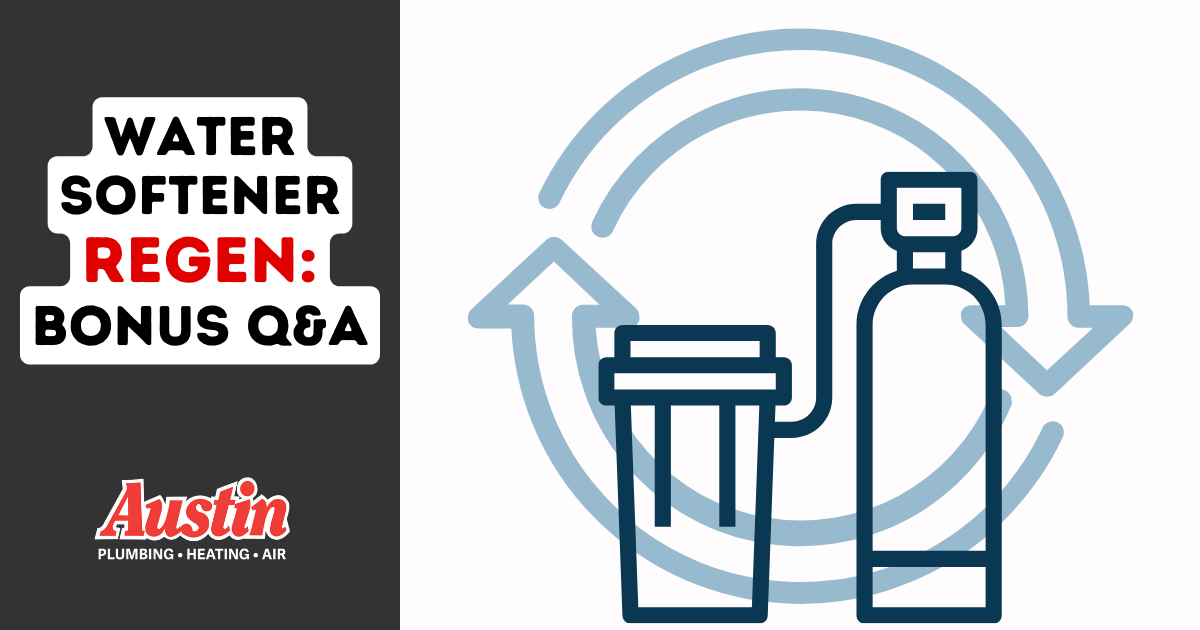Water Softener Regeneration: Top 5 Frequently Asked Questions

Our Master Tradesman gets straight to the point regarding five of your most-asked water softening questions.
We’ve talked about water softeners more than a few times, but it seems there’s still a handful of questions we haven’t answered. At long last, it’s officially here: the final installment in Team Austin’s water softening saga. Enjoy the trivia!
Q1: Why do water softeners regenerate in the middle of the night?
Night-owl customers tend to notice this. There are a few reasons for it:
- First, regeneration tends to be a rather noisy process. It’s counter-intuitive, but water softeners go off at night to avoid disrupting daytime activities, which tends to work out since they’re usually located away from bedrooms (in the living space or a nearby mechanical room).
- More importantly, any water used during the regeneration cycle will still be unsoftened. Yuck. Better to have it ready when everyone wakes up for the day, right?
- Above all, during certain portions of the regen cycle, the salt content of the water can be especially high, making it unsuitable for drinking or washing. At these times, it’s less of a preference thing and more of a safety hazard.
Q2: Can you program your softener to regenerate during the day?
Light sleepers and night-shift workers, we hear your plea. And the answer is yes. Yes, you can.
- The first and simplest method is to fool the time clock to mirror you by 12 hours. Basically, you just tell it to read the current time as AM rather than PM (or vice-versa). Voilà!
- If you prefer to keep the water softener’s internal calendar accurate, that’s fine, too. There are ways to get into the settings to change the default starting time for monthly regeneration. Again, peruse your user manual for instructions specific to your make & model. Just keep in mind that no water can be used during regeneration!
Q3: How long is one full regeneration cycle?
From start to finish, it takes about 1 to 2 hours.
- High-efficiency units are a bit on the longer side of that estimate, because they have to start by actually mixing the brine solution. (“But that sounds like the opposite of efficient,” you might say. We know. If you simply must sate your curiosity, here’s some recommended reading that touches on why “efficient” and “expedient” aren’t interchangeable terms.)
- On that note, low-efficiency units maintain a certain level of brine at all times. So they skip straight to the brine-drawing stage, wherein all water softeners draw the heavy salt water from the tank and introduce it into the softening media to clean and rejuvenate the water-softening media. This is why they’re able to regenerate fully in closer to an hour, unlike their energy-efficient cousins.
Q4: How much water does a softener use just to regenerate?
Somewhere between 75 and 100 gallons is a good conservative estimate.
- The majority of this water is used to flush out the tank after recharging the water softener bed. During this stage, it removes built-up traces of calcium and magnesium so that when you start using the softener again, the water that’s waiting for you is perfectly sanitary.
- If that seems like a lot of water, that’s totally fair. It kind of is! But it’s not wasted. It’s important to have access to clean, safe water. And it’s pretty cool to have technology that only has to do this every four weeks in exchange for guaranteed safe, soft water at all times.
Q5: Should you reset your water softener’s clock after a storm?
Well, most modern units have a backup battery. It’s this small, watch-type battery built into the control to keep tracking time during power outages, because of course, outages happen. But, like any battery, this one will also die one day. So don’t forget to replace it!
- Since you have to add salt on a monthly basis anyway, it’s a good idea to check the internal clock whenever you do that, and adjust the time if it’s off by more than a few minutes.
- We also recommend resetting the water softener to reflect the actual time if you encounter a lengthy power outage.
- Over the course of several years, a neglected unit can get so out-of-sync that you end up with a regen cycle that starts at 5:00am when you’re trying to brush your teeth, brew coffee, or get showered for work! Beyond this inconvenience, it can actually cause other problems with your plumbing system in the long term. Yikes!
Q6: Didn’t the title say there were only 5 questions…?
This is embarrassing. While we’re here, how’s your water softener? Austin Plumbing, Heating & Air has amassed more than 80 years of experience serving the people of Southeastern Wisconsin, and we’d love to help you, too. If you need anything, don’t hesitate to give us a call!





